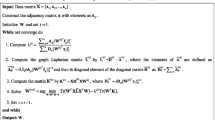Abstract
Linear subspace learning is of great importance for the purpose of visualization of high-dimensional observations. Sparsity-preserved learning (SPL) is a recently developed technique for linear subspace learning. Its objective function is formulated by using the \(\ell _2\)-norm, which implies that the obtained projection vectors are likely to be distorted by outliers. In this paper, we develop a new SPL algorithm called SPL-L1 based on the \(\ell _1\)-norm instead of the \(\ell _2\)-norm. The proposed approach seeks projection vectors by minimizing a reconstruction error subject to a constraint of samples dispersion, both of which are defined using the \(\ell _1\)-norm. As a robust alternative, SPL-L1 works well in the presence of atypical samples. We design an iterative algorithm under the framework of bound optimization to solve the projection vectors of SPL-L1. The experiments on image visualization demonstrate the superiority of the proposed method.






Similar content being viewed by others
Notes
The \(\ell _1\)-norm has been used once in the construction of the \(\ell _1\)-graph.
References
Belhumeur PN, Hespanha JP, Kriegman DJ (1997) Eigenfaces vs. fisherfaces: recognition using class specific linear projection. IEEE Trans Pattern Anal Mach Intell 19(7):711–720
Belkin M, Niyogi P (2003) Laplacian eigenmaps for dimensionality reduction and data representation. Neural Comput 15:1373–1396
Cai D, He X, Han J (2007) Isometric projection. In: AAAI proceedings of the 22nd national conference on artificial intelligence
Cheng B, Yang J, Yan S, Fu Y, Huang TS (2010) Learning with \(\ell ^1\)-graph for image analysis. IEEE Trans Image Process 19(4):858–866
Ding C, Zhou D, He X, Zha H (2006) R1-PCA: Rotational invariant L1-norm principal component analysis for robust subspace factorization. In: Proceeding of international conference on machine learning, pp 281–288
Donoho DL (2006) For most large underdetermined systems of linear equations the minimal \(\ell _1\)-norm solution is also the sparsest solution. Commun Pure Appl Math 59(6):797–829
Donoho DL, Elad M (2003) Optimally sparse representation in general (non-orthogonal) dictionaries via \(\ell ^1\) minimization. Proc Natl Acad Sci 100(5):2197–2202
He X, Cai D, Yan S, Zhang H-J (2005a) Neighborhood preserving embedding. In: Proceedings of the tenth IEEE international conference on computer vision, vol 2, pp 1208–1213
He X, Yan S, Hu Y, Niyogi P, Zhang H-J (2005b) Face recognition using Laplacianfaces. IEEE Trans Pattern Anal Mach Intell 27(3):328–340
Huang K, Ying Y, Campbell C (2011) Generalized sparse metric learning with relative comparisons. Knowl Inf Syst 28(1):25–45
Jain AK, Duin RPW, Mao J (2000) Statistical pattern recognition: a review. IEEE Trans Pattern Anal Mach Intell 22(1):4–37
Jenatton R, Obozinski G, Bach F (2010) Structured sparse principal component analysis. In: Proceedings of the 13th international conference on artificial intelligence and statistics
Jolliffe IT (1986) Principal component analysis. Springer, New York
Ke Q, Kanade T (2005) Robust L1 norm factorization in the presence of outliers and missing data by alternative convex programming. In: Proceeding of IEEE international conference on computer vision and pattern recognition, pp 739–746
Krishnapuram B, Carin L, Figueiredo MAT, Hartemink AJ (2005) Sparse multinomial logistic regression: fast algorithms and generalization bounds. IEEE Trans Pattern Anal Mach Intell 27(6):957–968
Kwak N (2008) Principal component analysis based on L1-norm maximization. IEEE Trans Pattern Anal Mach Intell 30(9):1672–1680
Lange K, Hunter D, Yang I (2000) Optimization transfer using surrogate objective functions. J Comput Graph Stat 9:1–59
Li X, Pang Y, Yuan Y (2009) L1-norm-based 2DPCA. IEEE Trans Syst Man Cybern B Cybern 40(4): 1170–1175
Liu Q, Lan C, Jing XY, Gao SQ, Zhang D, Yang JY (2012) Sparsity preserving embedding with manifold learning and discriminant analysis. IEICE Trans Inf Syst E95.D(1): 271–274
Meng D, Zhao Q, Xu Z (2012) Improve robustness of sparse PCA by L1-norm maximization. Pattern Recognit 45(1):487–497
Nene SA, Nayar SK, Murase H (1996) Columbia object image library (COIL-20), technical report CUCS-005-96
Nie F, Huang H, Ding C, Luo D, Wang H (2011) Robust principal component analysis with non-greedy L1-norm maximization. In: International joint conference on artificial intelligence, pp 1433–1438
Olshausen BA, Fieldt DJ (1997) Sparse coding with an overcomplete basis set: a strategy employed by v1? Vis Res 37(23):3311–3325
Pang Y, Li X, Yuan Y (2010) Robust tensor analysis with L1-norm. IEEE Trans Circuits Syst Video Technol 20(2):172–178
Qiao L, Chen S, Tan X (2010) Sparsity preserving projections with applications to face recognition. Pattern Recognit 43:331–341
Roweis ST, Saul LK (2000) Nonlinear dimensionality reduction by locally linear embedding. Science 290:2323–2326
Sugiyama M (2007) Dimensionality reduction of multimodal labeled data by local Fisher discriminant analysis. J Mach Learn Res 8:1027–1061
Sun J, Tao D, Papadimitriou S, Yu P, Faloutsos C (2008) Incremental tensor analysis: theory and applications. ACM Trans Knowl Discov Data 2(3):1–37
Tenenbaum JB, de Silva V, Langford JC (2000) A global geometric framework for nonlinear dimensionality reduction. Science 290:2319–2323
Wang H (2012) Block principal component analysis with L1-norm for image analysis. Pattern Recogn Lett 33(5):537–542
Wang H, Tang Q, Zheng W (2012) L1-norm-based common spatial patterns. IEEE Trans Biomed Eng 59(3):653–662
Wright J, Ma Y, Mairal J, Sapiro G, Huang TS, Yan S (2010) Sparse representation for computer vision and pattern recognition. Proc IEEE 98(6):1031–1044
Wright J, Yang A, Sastry S, Ma Y (2009) Robust face recognition via sparse representation. IEEE Trans Pattern Anal Mach Intell 31(2):210–227
Yan S, Wang H (2009) Semi-supervised learning by sparse representation. In: Proceedings of the SIAM international conference on data mining, Nevada, USA, pp 792–801
Yan S, Xu D, Zhang B, Zhang H-J, Yang Q, Lin S (2007) Graph embedding and extensions: a general framework for dimensionality reduction. IEEE Trans Pattern Anal Mach Intell 29(1):40–51
Yang J, Zhang D, Frangi AF, Yang J (2004) Two-dimensional PCA: a new approach to appearance-based face representation and recognition. IEEE Trans Pattern Anal Mach Intell 26(1):131–137
Yin F, Jiao LC, Shang F, Wang S, Hou B (2012) Fast Fisher sparsity preserving projections. Neural Comput Appl. doi:10.1007/s00521-012-0978-2, online first
Acknowledgments
The authors would like to thank the anonymous referees for the constructive comments, which are helpful to improve the paper.
Author information
Authors and Affiliations
Corresponding author
Additional information
This work was supported in part by the National Basic Research Program of China under grant 2011CB302202, in part by the National Natural Science Foundation of China under Grant 61075009, in part by the Natural Science Foundation of Jiangsu Province under Grant BK2011595, in part by the Program for New Century Excellent Talents in University of China, and in part by the Qing Lan Project of Jiangsu Province.
Rights and permissions
About this article
Cite this article
Wang, H., Zheng, W. Robust sparsity-preserved learning with application to image visualization. Knowl Inf Syst 39, 287–304 (2014). https://doi.org/10.1007/s10115-012-0605-7
Received:
Revised:
Accepted:
Published:
Issue Date:
DOI: https://doi.org/10.1007/s10115-012-0605-7




